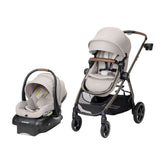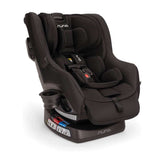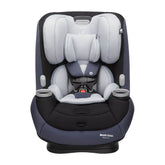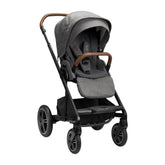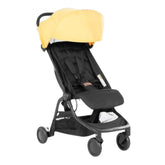Why Babies Won’t Sleep in Their Crib and How to Change It

Babies spend a lot of time sleeping…but that doesn’t necessarily mean they spend a lot of time in their cribs. They’ll nod off in the car, on a stroller ride, while you’re holding or feeding them. Babies will get their ZZZs just about anywhere except in the very spot you’ve designated for this purpose. Why won’t some babies just sleep in their cribs?
Making sure your baby always sleeps in their crib is essential since, according to the American Academy of Pediatrics (AAP) safe sleeping guidelines, it's the safest (and best) place for your baby to sleep. Plus, setting healthy sleep habits now will help your baby sleep better as they grow. It’s more difficult to alter those sleeping habits after an infant passes the 6-month-old mark. A 2018 study published in Sleep Medicine found that babies sleep less and wake more frequently when they're not in their crib, so it makes sense to take action as early as possible. Here are some tips for how to get your baby to sleep in their crib.
Why Babies Won’t Sleep in Their Cribs
Think about it: newborns spend the first nine months of existence nestled in the comfort and safety of the womb. They’re enveloped in soothing white noise, never hungry, and constantly lulled to sleep by the rocking of mom’s movement. After they’re born, they’re thrust suddenly into a world where they’re expected to sleep all alone in a wide-open crib. That’s a pretty tall order for one so tiny.
When it comes to older babies and toddlers, they simply like being near their caregivers. It’s reassuring and comforting. And since it’s impossible to reason with babies and toddlers, trying to convince them to sleep in their crib can be exasperating for adults.
If you’ve had previous success with putting your infant in their crib to sleep and are suddenly hearing cries of objection, it could be a phase they’re going through. A few reasons it may be happening could include
- discomfort from teething (gum soreness can start months before a tooth ever appears)
- sleep regression, a normal reversal in a baby’s sleep patterns that may occur around 4 months, 6 months, between 8 and 10 months, and again at 12 months of age
- an ear infection, rash, cold, or other illness
- growth spurts and their accompanying increase in appetite, typically around the ages of 3 weeks, 6 weeks, and 3 months of age
- distractions from new milestones, like sitting up and rolling over

Getting Your Newborn to Sleep in Their Crib
For starters, ensure their crib set-up is safe. The American Academy of Pediatrics recommends setting up the crib in your room at least for the first 6 months, preferably through the first year. Always place babies on their backs on a firm surface with no loose items (blankets, pillows, toys, crib bumpers). You should also evaluate other elements about your little one’s sleeping environment:
Keep the room cool.
Overheating is a risk factor for SIDS (Sudden Infant Death Syndrome). A fan may be helpful and provide additional white noise.
Keep the room dark.
Nightlights can help keep things subdued during middle-of-the-night diaper changes or feedings. A sturdy set of blackout curtains may help with naps.
Ensure baby’s tummy is full.
Newborns eat often (especially breastfed babies) so make sure you’re feeding them every 2 to 3 hours, 8 to 12 times a day.
Wrap them up.
Swaddling or using a sleep sack can help a newborn feel more secure (just like the womb). Stop swaddling, though, once they’re able to roll over.
Use scent to your advantage.
Babies find their caregiver’s scent familiar and soothing. Try sleeping with their swaddler, sleep sack, or bed sheet before they use it so that it will smell like you.
Play soothing sounds.
Use a white noise machine or app to replicate the quiet, muffled sounds of the womb.
Put them in comfy PJs.
Dress your baby in the appropriate pajamas. They should be made of appropriate weight material and offer a snug fit with no loose strings.
Establish a routine for sleep, whether it’s naps or nighttime.
This may include a bath, reading a book, rocking, dimming the lights, or playing music. Put your baby into the crib while they’re still drowsy, but not fully asleep.
If your baby startles or fusses when you lay them down, gently place a hand on their tummy and quietly shush or sing to them for a moment. You may need to “rinse and repeat” cuddling and putting them down several times. This is normal and part of the learning process – it just takes practice and patience. Give them snuggles or feeding as needed at night, but continue to return them to the crib once you’ve met their needs. Keep bright lights, talking, and other disruptions to a minimum.

Getting an Older Infant or Toddler to Sleep in Their Crib
Convincing an older baby or toddler to sleep in their crib may be even more challenging than getting a newborn to do it. Try these tips to ease the transition:
Implement changes slowly
Try to get your little one to take their first nap of the day in the crib. If that’s successful, add another. Gradual changes are especially helpful when trying to figure out how to get your baby to sleep in the crib after bed-sharing.
Be consistent with your routine
Keep nap and night routines similar where possible. Knowing what to expect next helps give your little one a feeling of security and predictability that can make transitions smoother.
Determine what works for your child
If your little one will sleep in the crib for naps but not at bedtime, try to figure out what’s bothering them. Do they sleep better with noise or motion? If they fall asleep easily in the car or stroller or while you’re in a noisy restaurant, find ways to add those things to their crib setup. White noise machines or vibrating mattress pads may help imitate an environment they find comforting.
Consider sleep training techniques
There are lots of methods out there, from crying it out to the Ferber Method. Research different sleep training methods, and choose the one you’re comfortable implementing.
The Bottom Line
If you’re trying to figure out how to get a baby to sleep in the crib without crying, you should probably level your expectations a bit. There will likely be a few tears. But like everything else parenting-related, teaching your child to sleep in their crib is a learning process for both of you. Using what works best for your baby and sticking to a consistent routine that works well for both of you can help build healthy sleep habits for the future.

